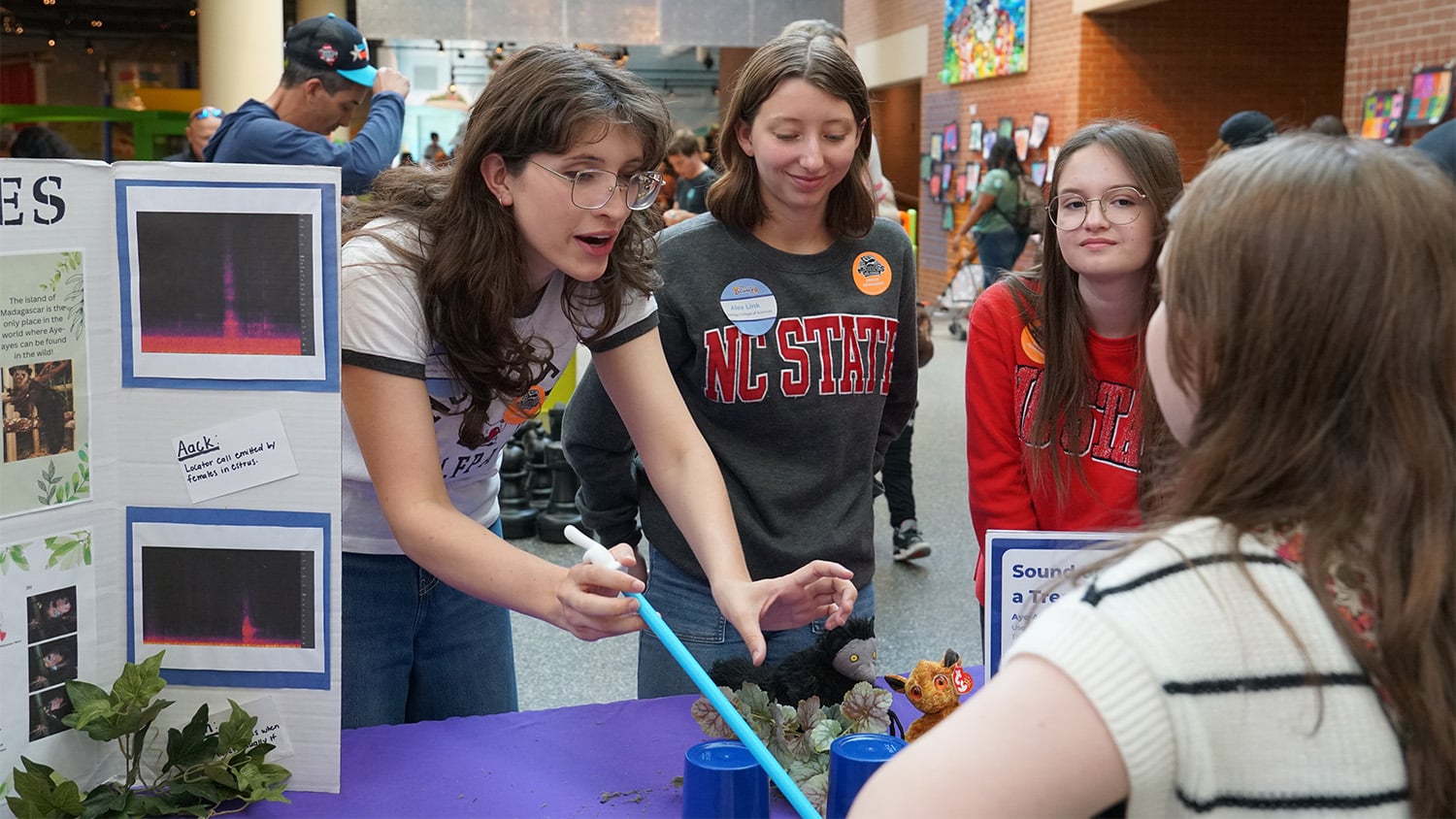Still the Farmer’s Best Friend
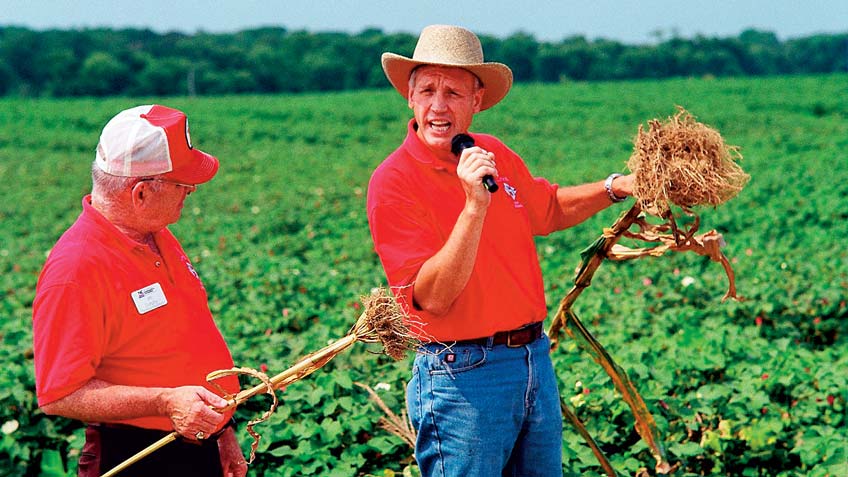
Editor’s note: This story, from NC State magazine, traces the past, present and future of the N.C. Cooperative Extension Service, which is celebrating its centennial. NC State magazine is a benefit of membership in the NC State Alumni Association. For information on how to join, visit www.alumni.ncsu.edu. Photography by Jason Miczek.
Nowhere is NC State’s reach into every corner of the state more evident than through the N.C. Cooperative Extension Service. Extension agents are stationed in each of North Carolina’s 100 counties, helping farmers, gardeners, students, homeowners and others with everything from tips on how to grow a greener garden to providing farmers with the financial wherewithal to turn their operations into viable businesses.
It began, officially at least, 100 years ago. On May 8, 1914, President Woodrow Wilson signed into law the Smith-Lever Agricultural Extension Act, and land-grant universities such as NC State and N.C. A&T State University have been working ever since to connect the research happening on campus to the real-world challenges being faced around the state.
The N.C. Cooperative Extension Service has been hard hit in recent years by reductions in federal and state funding. But NC State recently announced a new plan to restructure the organization, ensuring that it will continue to have a presence in all 100 counties (as well as with the Eastern Band of Cherokee) while providing some services on a regional level. “An essential objective throughout this process was to ensure that the public continues to have access to trusted, research-based information,” says Joe Zublena, director of the extension service at NC State.
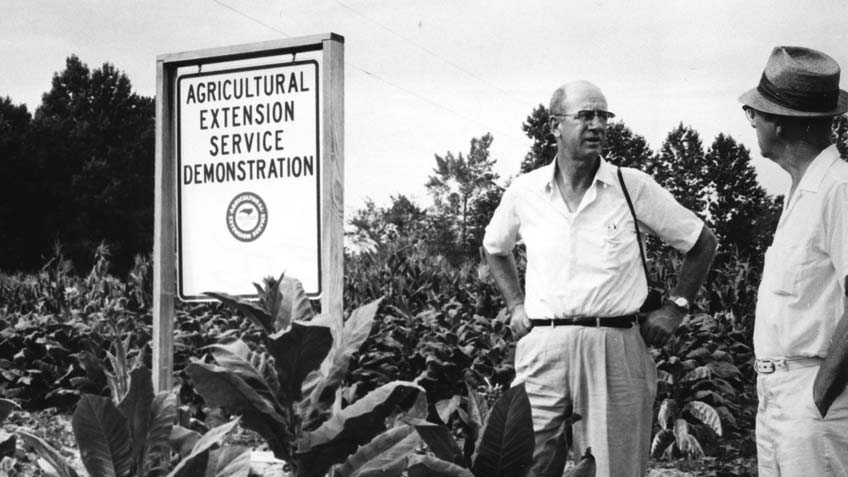
This year, as the N.C. Cooperative Extension Service celebrates its 100th anniversary, its work is keeping pace with the new look of agriculture in North Carolina, from the fields in Hyde County in eastern North Carolina to the seeds of the Cherokee in the state’s western mountains. Read on to find out how extension is preserving North Carolina’s agricultural heritage, giving a helping hand to a new breed of farmers and working with existing farmers to learn new technological tricks — confronting the legacy and challenges of the past, present and future of North Carolina agriculture.
The Past: Seeds of Time
It is impossible to miss Harrah’s Cherokee Casino Resort. Driving through town, the 21-story luxury hotel towers over the highway, a gleaming, polished sign (some would call it an omen) of the times, a place that has helped the Eastern Band of the Cherokee Nation build new schools and hospitals.
But continue driving west on U.S. 19, past the gift shops and abandoned motels, and you will find another building that some would argue tells even more about the Cherokee and their culture. This one is easy to miss — it’s a one-story cinderblock building with a small sign above the door. It is the Center for Cherokee Plants, where a couple of N.C. Cooperative Extension Service agents are helping the tribe reclaim remnants of its past.
Kevin Welch and Sarah McClellan-Welch (they are married to each other; he is Cherokee, she is not) are extension agents for the Cherokee nation. They created the center as part of a larger effort to help the Cherokee develop better eating habits, hoping that if more tribe members grow their own produce they will reduce the high rate of obesity and diabetes within the tribe. They are doing that, in part, by helping the Cherokee savor a bit of their agricultural past. “We’re not bison-hunter people. We’re not salmon people, like the folks in the Northwest,” says Welch, whose family maintained a large garden when he grew up here. “We’re agriculturally based here. This is where we come from.”

And so Welch has set out to track down, propagate and share some of the heirloom seeds that his ancestors grew to feed their families for generations. Those seeds are then given out in garden kits each year, with the hope that Cherokee families will take the time to plant and tend to seeds of the vegetables and fruits that their grandparents and great grandparents may have grown. “A lot of people, when you talk to them about the old varieties, like the October beans and the Willow Leaf beans, it’s that comfort food you had as a kid,” says Welch. “Everybody has different memories on which varieties they liked and how their families used them.”
Welch, for instance, savors the heritage White Indian peach, a small, sweet fruit that grows on a tree in his yard. His wife, McClellan-Welch, enjoys the Candy Roaster squash, a sweet and tasty vegetable that looks like a long, orange football. “The heirloom varieties are thought to have more taste and are often more tender,” she says. “They’re not varieties that were developed for transport. The Cherokee Purple [tomato], for instance, has a very short shelf life.”
Welch doesn’t worry about whether the seeds he collects were unique to the Cherokee, focusing instead on whether they were grown and enjoyed here at some time. He relishes the stories elders share about some of the seeds, but is reticent to relate those stories to outsiders. “There are some seeds that have to do with certain ceremonies that aren’t open to public knowledge,” he says. “It is sharing within a culture.”
But Welch is happy to share a story about how he managed to track down the seeds for the Cherokee Tan Pumpkin, which had not been grown in Cherokee since the tribe was forced to leave the area in the 1830s (an event which came to be known as “The Trail of Tears”). As the Cherokee were forced to move west, Welch says, the women sewed seeds into the hems of their aprons, skirts and blouses so they could be certain to have the means to feed their family at the end of their journey. About eight years ago, Welch visited Oklahoma to speak with the Choctaw Nation and share 26 varieties of seeds with them. While he was there, he met a Cherokee woman who was married to a Choctaw man. She gave Welch six Cherokee Tan Pumpkin seeds, and Welch planted three of them upon returning to Cherokee. (“One for God, one for the crow and one for me,” he says, reciting an old Cherokee adage.) Those seeds produced 180 pumpkins, and plenty of seeds for Welch to preserve and later share with other Cherokee.
“You see them at the fair now — people bring them for competitions,” he says. “That was a success story. A plant that hadn’t been grown here in 160-plus years was reintroduced.”
Welch has about 40 varieties of seeds at the center now, noting that he does not keep seeds that can be easily purchased commercially. But he knows that there are plenty of seeds still waiting to be found. “We’ve had 4,000 or 5,000 years to develop a bunch of varieties, so, yeah, the puzzle is far from being finished,” he says. “But it’s still out there. That’s the fun part of it, the chase.”
But he also takes some measure of satisfaction from what happens once he finds a new seed, and shares it with others in the tribe. “What I do isn’t research to go on a shelf somewhere,” he says. “It’s actually about the person that’s putting food on the table to feed their families. Period.”
The Present: A New Way to Train a New Type of Farmer
Rebecca Wright and her husband, John Montero, weren’t sure how to transition out of the corporate world into farming their 9.1 acres in Iredell County on the outskirts of Charlotte, N.C.
“We didn’t know quite what we wanted to do,” says Wright, who reviewed contracts as a paralegal for the Lowe’s Corporation. “We just wanted to grow something.” So they enrolled in the Piedmont Farm School, a venture launched by the N.C. Cooperative Extension Service a couple of years ago to give new farmers a fighting chance to be successful.
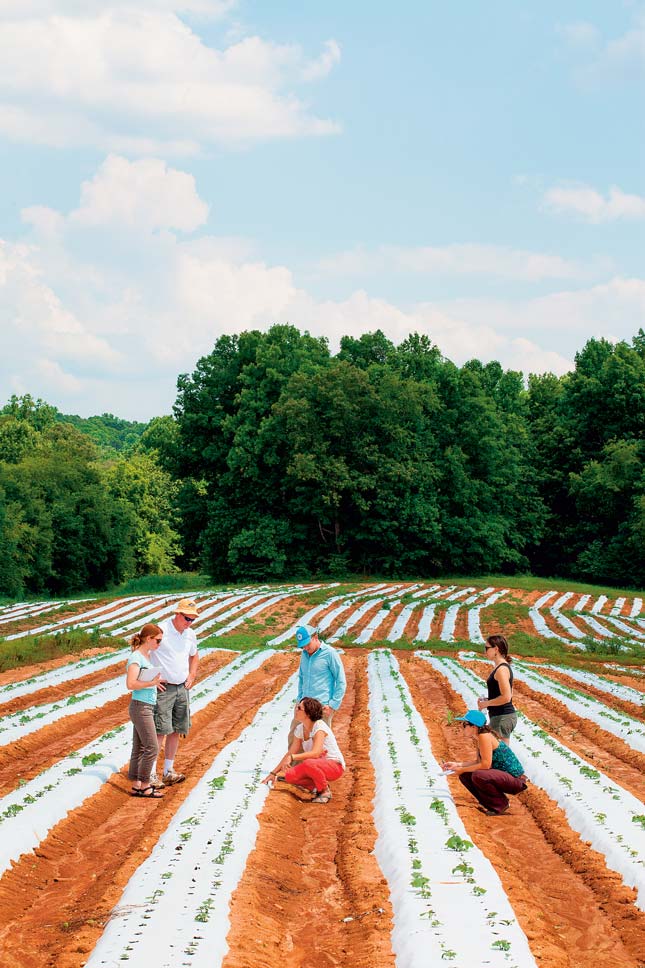
The school combines classroom sessions on the business side of agriculture — from financial record keeping and taxes to marketing and cost controls — with visits to working farms where students can learn about the successes and failures of farmers who have some experience. “It helped us focus on what we could do and what wouldn’t work for us,” says Wright. “It was a total eye-opener. They put us two to three years ahead on the learning curve.”
Wright and Montero represent a new breed of farmer following an increasingly common trend as people seek to regain control over the food they serve and eat. Now Wright and Montero grow apples, peaches, pears, strawberries, blueberries and, she says, the “most wonderful tomatoes you’ve ever eaten.” They sell their produce at a couple of farmer’s markets as well as to regular customers who come to their farm. Wright says the farm is not profitable yet, but that they are pleased with their progress.
That is what Amy-Lynn Albertson, an extension agent in Davidson County, envisioned when she came up with the idea for the Piedmont Farm School. With more people wanting food that is grown locally, more people were contacting extension offices about how to go about starting their own farm. “Suddenly, we have a whole lot of people who have no agricultural background at all,” she says. “Our goal is to help people approach it as an enterprise, as a business.”
Gary Bullen, an expert on farm management with the N.C. Cooperative Extension Service, keeps things encouraging and upbeat as he speaks to students in a classroom in the cooperative extension building in Forsyth County. It’s clear that he wants nothing more than to help the people in the room become successful farmers. But he knows that their chances for success increase if they go into this new venture with their eyes wide open, as well as a healthy dose of knowledge about the business side of farming. He is relentless in his questions: What motivates your customers? What makes them want to buy your product? What’s your competitive advantage? Why do people buy from you?
“There’s a lot of optimism, particularly with new farmers,” says Bullen, whose office is on NC State’s campus. “And so we try to paint a realistic picture — here’s what it really takes to make it work. I don’t want to tell anybody it’s impossible. But I want folks to walk in and say, ‘If I do this, here’s what it takes to do it.’”
When the school was launched in 2012, there were skeptics who wondered if anyone would be willing to fork over $150 (or $200 for a couple and $250 for a family) and commit to seven three-hour classroom sessions and seven field trips over the course of four to five months. Albertson and others were hoping for at least 10 people. Once registration opened, they quickly had 34 people signed up and ended up with a waiting list. The second year, the tuition increased, but the classes still filled up. Students included a couple that owned dry cleaning establishments, a veteran who had recently returned from Iraq, an elementary school student and a brother-sister team in their early 20s.
“We thought, ‘Well, we’re doing something right,’” Albertson recalls. “Something must be interesting about this.”
Bevin Fink was one of the students drawn to the school. Fink and her husband, Troy, had tried their hand at growing cut flowers and baling hay on the 17 acres they own in Rowan County. “It went OK, not great,” she says. The Finks were looking for more from the land they bought in 1996. After watching Food, Inc., a documentary about the increasingly corporate nature of food production in the United States, they wanted to change the way they and their four children ate. They also wanted to supplement the income that Troy earned as a paramedic. “We liked the idea of farmers being the caretakers of creation,” she says. “That’s what we needed to be. But we weren’t sure how we were going to go about it.”
Fink says the visits with other farmers were invaluable, as were the business lessons in finding a market for what they produced and tracking their actual costs. She used that information to set a price for her eggs — $4 a dozen — that was higher than what others were selling eggs for at the farmers market in Huntersville, N.C. “I know what it costs me to produce a dozen eggs, so I can’t charge less than that,” she says. What happened, though, was a pleasant surprise. Fink sold out of her eggs every week, and soon other vendors were raising the price of their eggs to match hers — not lowering them to undercut her.
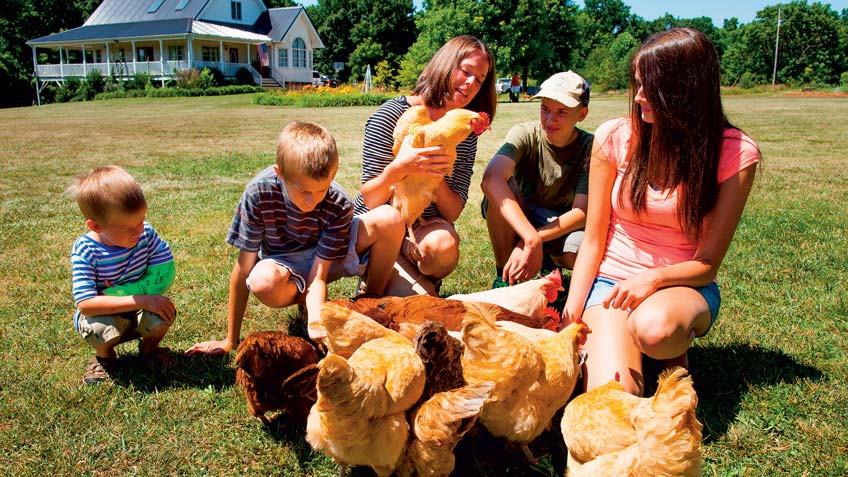
The farm school also plugged the Finks into a network of other farmers — some experienced, some not — whom they continue to call on with questions or to join forces with to sell items in larger quantities. She has hired a couple of interns — an idea she got at the farm school — who work for free in exchange for the experience of learning the ins and outs of farming.
As a result, the Finks’ farm (named Third Creek Cottage Gardens, a nod to Fink’s love of British literature) is enjoying slow but steady growth, a reflection of the Finks’ determination to be successful without relying on loans. She gives much of the credit to the Piedmont Farm School. “It helped us cut out some of that trial and error,” she says. “We learned so much as far as keeping us on the right track.”
The initial success of the Piedmont Farm School has led to the creation of three more farm schools throughout North Carolina, with one of them near a military base to help returning veterans. “It’s moved a lot faster than I ever thought it would,” says Albertson. “I never really knew that people would just be clamoring for this information.”
The Future: From Plows to Drones
As a kid growing up on a 640-acre farm in Kansas, Ron Heiniger loved it whenever he got a chance to drive a tractor or a combine. Today, kids may never get that chance, but not because Mom or Dad won’t allow it. It’s because the tractor may not need a driver.
Welcome to the new age of agriculture, where tractors routinely rely on GPS to pilot themselves, and drones (or UAVs, unmanned aerial vehicles) are increasingly used by farmers to survey their fields to pinpoint diseases or apply chemicals. Heiniger, a professor of crop science and a cropping systems specialist at the Vernon G. James Research and Extension Center in Plymouth, N.C., works with farmers to help them understand the different ways that new and emerging technologies can be used to help them increase the yield and profits on their farms.
NC State magazine spoke with Heiniger about how today’s farmers are using the new technologies and how they are changing the face of modern agriculture.
On identifying diseased plants: “When there are diseases in the field, often times that plant reflects light differently. You can use a sensor [on a drone] that measures how much light is reflected by a crop so you can tell where that disease is, pinpoint it in the field. Some diseases, such as potato blight, it’s not visual until it’s already infected the plant. So the plants wilt. With these sensors, we can measure the plants’ reflection before we can visually see it. Then we can treat it quicker.”
On using drones: “In the future I see, a farmer pulls up in his pickup. But instead of getting out and wandering in the field, he launches his UAV and takes pictures of his field. If he sees problems, he zooms down to get a close-up picture. Then he loads the map [using GPS coordinates collected by the drone] into his sprayer and only puts the chemicals where he needs it. He may not even have to use a tractor. He may be using a small drone helicopter to apply the material. It changes the dynamics of timeliness and accuracy.”
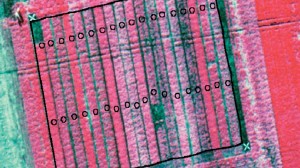
On the advantages of tractors that steer themselves: “It has reduced labor. It has made the use of fertilizers more efficient. In the past, there was no way to avoid overlaps or skips in the field. Now you can have it down to the inch. You have less overlap, less waste, less skips. The tractors can go faster in the fields, so you’re covering more acres in an hour.”
On how farmers are adapting to the technology: “A farmer is a great entrepreneur. He knows when something is working for him and making him money. He’s a quick adapter.”
On what’s next: “There are not many farmers who don’t have auto-steer tractors or sprayers. Looking into the crystal ball is getting more difficult. Things happen so fast you can’t even imagine it. In five to 10 years, these little UAVs will be in the back of nearly every pickup. There’s going to be an increasing reliance on automated systems and information. Farmers are going to spend more time looking at apps and computers, and less time driving the tractor. Today, your cell phone is a GPS receiver and a computer. In the future, you may just have a pair of Google glasses, so you won’t even have to hold a phone in your hand. I’m sure they’ll come up with some new way, maybe a hologram.”
- Categories:


